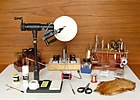Mallard and Claret
Appearance
| Mallard and Claret | |
|---|---|
| Artificial fly | |
| Type | Wet fly |
| Imitates | minnow, attractor, or deceiver |
| History | |
| Creator | William Murdoch |
| Created | 1850s |
| Materials | |
| Typical sizes | 8-14 |
| Typical hooks | original used a double hook |
| Thread | Black |
| Tail | 7-8 fibres of golden pheasant tippet |
| Body | dubbed claret seal's fur |
| Wing | Rolled wing from a Mallard Bronze shoulder feather |
| Ribbing | silver or gold wire |
| Hackle | black hen hackle |
| Head | Tying thread |
| Uses | |
| Primary use | brown trout |
| Other uses | sea trout |
| Reference(s) | |
| Pattern references | [1] |
Mallard and Claret is a popular fishing fly in the United Kingdom. Also known as the 'M and C' it is a good general pattern that imitates a wide range of trout food items. The Mallard and Claret fly was created in the 1850s by Aberdeen fly tyer William Murdock.
Materials
[edit]As its name suggests, this fly is constructed from the feathers of a mallard duck together with a claret coloured body.[1][2][3]
References
[edit]- ^ a b "Mallard Claret Wet Fly". Dragon Flies. Retrieved March 8, 2021.
- ^ "Mallard and Claret". Diptera. Retrieved March 8, 2021.
- ^ "Mallard and Claret Double Hook Wet Fly". Retrieved March 8, 2021.


